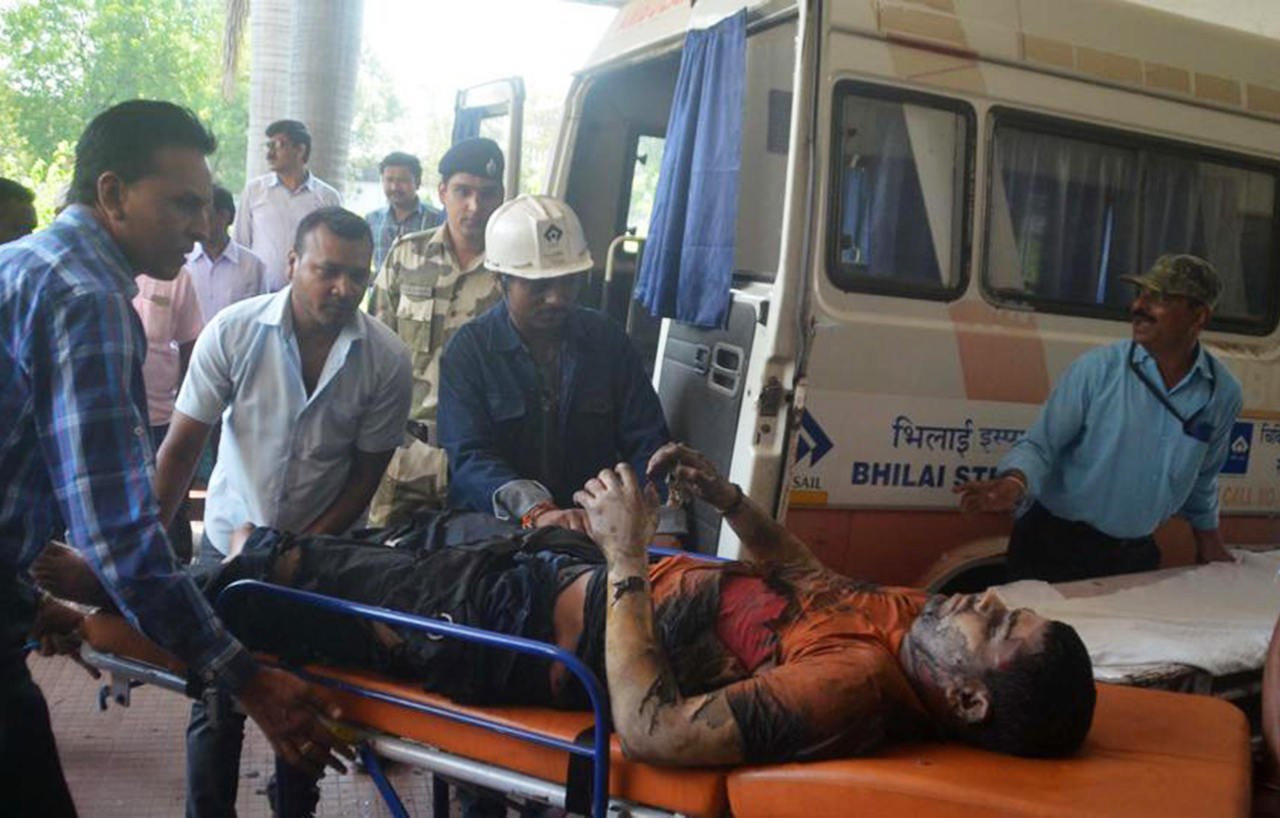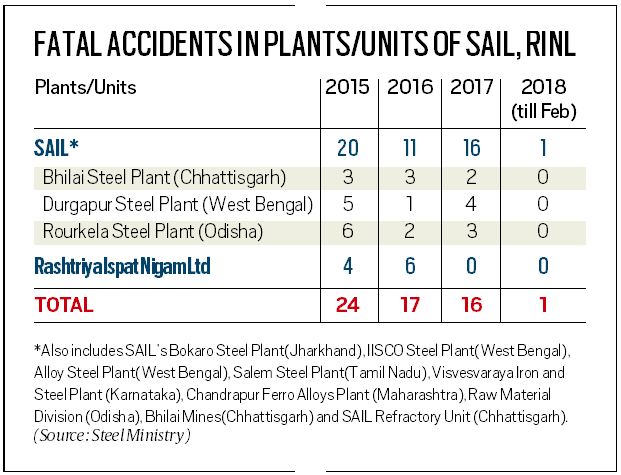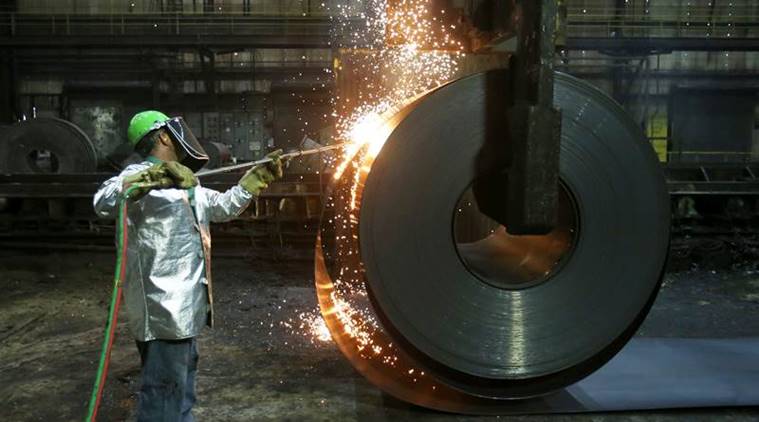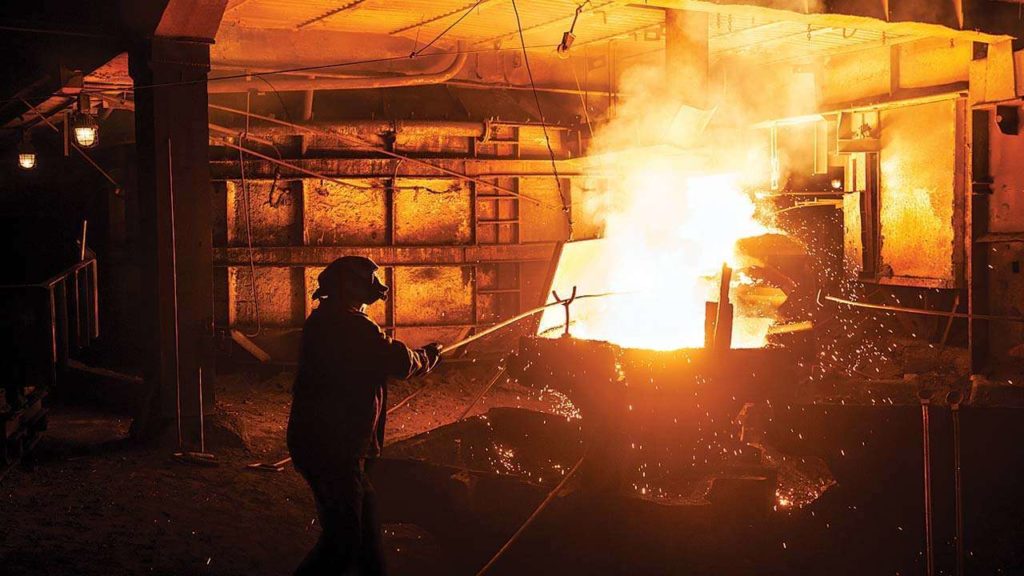On the 9th of October 2018, fourteen workers were burnt alive and another ten were seriously injured in a gruesome accident in the Energy Management Department of Bhilai Steel Plant (BSP). The ghastly accident once again pointed to the fact that scant value is attached to the lives and health of workers. The management, both in the public or private sector exhibits callous attitude towards safety standards and protocols leading to such incident which maim and kill workers at regular intervals. A brief report compiled by Groundxero based on the investigation of the accident done by a fact finding team.
A ‘fact finding team’ consisting of lawyers and social activists was constituted to study the accident and prepare a report for public discussion and action. The members in the team included Advocate Nikita Sonawane, trade unionist Ashim Roy and social activist and researcher Sujata Gothoskar. The team was in Bhilai for three days from the 4th to the 6th of December 2018. It met several groups of workers in BSP and the Fire Brigade department of the BSP, and contract workers and relatives of contract workers who had been seriously injured or had died in other accidents in BSP.
The Fatal Accident
On the fateful day a team of 23 employees of the Energy Management Department (EMD) of the BSP, owned and operated by the Steel Authority of India Ltd (SAIL – a Government of India undertaking), were engaged in de-blanking (removing the dummy plate inserted in the flange) a gas pipe of 1800 mm diameter at a height of about 40 feet from the ground. It was during this process of de-blanking that there was a sudden fire explosion, burning the workers in the vicinity. A rescue team of 10 fire brigade personnel was also present at the scene. This team too was engulfed in the explosion leading to the death of five firemen. While some were burnt in the fire explosion others fell down from the height. Nine died on the spot and five died later in the hospital.
Two days later the then Union Minister of Steel along with the then State Chief Minister visited BSP. The Union Minister announced ex-gratia payment of Rs 30 lakh to the families of each of the deceased employees, Rs.15 lakh to the seriously injured employees and Rs. 2 lakh to employees with minor injuries. The Union Minister told media persons that apart from the internal enquiry committee constituted by SAIL that was announced a day before, another high-level Enquiry Committee comprising of experts from across the country would be constituted to enquire into the actual causes of the incident by the Ministry of Steel. Pending enquiry, CEO M Ravi was removed (sent on leave) and Mr. Pandiaraj, General Manager Safety Department and Mr. Dasha, Deputy General Manager, Energy Management Department were suspended.
The reports of the two official committees have not yet been made public. RTI applications have been filed in order to access these reports but the request to access them has not been granted. An enquiry was also conducted by Hindustan Steel Employees Union (affiliated to Centre of Indian Trade Unions, CITU) Bhilai which released its report on 20th October 2018. The union report goes into the immediate causes of the accident and also draws attention to the absence of any duly constituted statutory safety committee.
What lead to the accident?
It was quite clear this was not an ‘accident’ in the sense that it was unforeseen or an improbable event; it was well known that de-blanking gas pipes involves a high probability of leakage of toxic gases and also fires and explosions. The management which ordered the de-blanking process was well aware of the possibility of accident and it appears to have somehow assumed that the likelihood of a fire explosion was negligible and only prepared the team for handling toxic gas.
The Hindustan Steel Employees Union enquiry report too indicates that most of the safety protocols were ignored. The report points to a major breach of protocol – the pipe lines had not been depressurized before the de-blanking process was begun. To quote the report, “The job was carried out in gas line under gas pressure, which is a gross negligence of safety on the part of concerned management, because working in gas line under gas pressure cannot be justified, if provision of isolating gas flow like U-seal, valves etc are there.”
It seems that the management was keen not to disrupt production due to the de-blanking operation and hence decided to carry on with the operation without completely stopping gas flow and depressurizing the pipes. Following the protocols would have meant disruption of production for about 2 to 3 hours. The next protocol action of purging the pipes with nitrogen gas was also not done.
The ‘accident’ and the scale of fatalities was thus entirely preventable but for deliberate negligence by ignoring the risk of fire on the part of the management and the persons responsible for the de-blanking procedure in particular.
Workers also talked about a horrendous accident in January 1986, when 9 workers had been killed. The October 9 accident was almost identical to the 1986 one. Still the workers are goaded into such dangerous work through a system devised by the management whereby they are rewarded with ‘bravery awards’.
Workers during interaction with the fact finding team said that it is often an unspoken practice that those willing to take risks for the sake of cost-cutting and increased productivity, inevitably involving the compromise of safety norms and procedures, are assured that their names would be forwarded for such awards to the higher authorities.
This is obviously a despicable practice of encouraging and pressurizing workers to violate safety norms. Sadly and ironically some of the workers who lost their lives had been previously awarded thusly.
Total failure of rescue backup
As the safety norms were flouted, and protocols ignored, the rescue system with open vehicles approaching the site of accident and ambulances facilities too were found lagging. It took hours to shift 23 persons to the hospital just because there was no approach route for vehicles to reach the site of accident.
This is what a worker had to say about the situation:
“The BSP Sector 9 has just five ambulances, and at any given time there are at the most two or three at the plant, sometimes only one. Because of this, we had to do several rounds between the accident site and the hospital. One ambulance could only take two injured people, so we would go drop two, come back, pick another two up and then go back again. This went on for one and a half or two hours. If there were more ambulances, or if the management had bothered to quickly hire a few more private ones, more lives might’ve been saved, or at least some injuries might’ve been less severe.”
Another huge problem he said was that there was no proper approach route to the site of the accident, that there was no place for the ambulance to park because the coke oven is beside the railway track. “The first ambulance had to drive around in all directions for the first few minutes searching for the best approach to the site. We just didn’t know where to park. Finally, we found a spot and then we had to walk and carry bodies for a distance of about 150-200meters.” The fact that such a high risk department with highly combustible gas flowing at high pressure has no approach route for an ambulance to arrive in case of an accident shows the utter lack of commitment to safety of the workers that BSP management has.
The fire brigade employees also recalled before the fact finding team how over the last few decades, hardly any safety training has been carried out The number of employees in the fire brigade department has been reduced by more than 50%, from about 500 to around 200 now. Regular safety training and updation is a thing of the past. This reiterates the complete neglect of safety and the callous attitude to workers’ lives in the BSP.
Failure to constitute Departmental Safety Committees
According to the investigating team, one of the main lapses on the part of the management in BSP appears to be the failure to constitute the Statutory Safety Committee. As per Section 41-G of the Factories Act (1948), in every factory where there is a hazardous process, the management must set up a Safety Committee with equal number of representatives from the management and the workmen. However, according to the Hindustan Steel Karmachari Union Report no such committee has been in place for the last two years.
Safety committees play a crucial role in ensuring compliance with safety protocols and presence of workers with shop floor experience is vital in its functioning. Infact, many of the security lapses which resulted in the 9th October and other accidents could have been avoided had workers’ advice on these matters been heeded.
The case of contractual workers
The ‘accident’ of 9th October 2018 was not a rare exception but part of a long series of industrial accidents claiming lives and limbs of workers and also impacting production. The difference was that the fatalities on 9th October involved ‘regular and permanent’ workers while the previous accidents mainly involved contract workers towards whom the management showed no responsibility. Even the trade unions seem to have largely ignored them.
As per SAIL’s annual report for 2017-18, it employed more persons on contractual or casual basis than permanent workers. There are 65,152 regular workers to 66,186 on temporary/contractual/casual basis. In recent decades the BSP management has resorted to subcontracting on a very large scale. At this point in time, BSP has more than 50% contract workers. Contract workers are deployed in each department. They are neither paid minimum wages nor do they get any safety equipment. Production has increased tremendously and the number of workers has reduced.
As per the Factories Act (1948), all safety provisions apply equally to contract workers and permanent workers but the contractors and subcontractors appear to be ignorant of safety issues, and lack training or orientation; their main concern is cost-cutting by any means necessary. These subcontractors recruit unskilled agricultural workers or poor peasants who are not even given safety gears let alone training in such matters. This has resulted in a large number of accidents in which the contract workers are the victims.
Of course officially the BSP claims a commitment to orienting and training contractors and contract workers in issues of industrial safety; in actual practice this is not so. Let us listen to some remarks made by the workers during the investigation:
“Very often work that requires technical expertise like operating a crane and other things are given to contract workers who are at the plant site for a few months at best. Some of them are actually agricultural workers who come in search of work for two months in a year when farming activities are suspended. They are given no proper training and guidance, but made to work in units that require technical skill.”
Another worker recalled an incident where a job to dismantle an old crane was outsourced to a contractor who brought in daily-wage unskilled workers for the task.
“Dismantling a crane is no small task; it requires an elaborate plan. However, with no training and technical knowledge, the contractor got daily wage workers to do the job who just began indiscriminately welding at various points. A wrong choice of spot led to a massive part of the crane to break off and fall on one of the workers who was welding.”
It is a matter of deep concern that such fatal accidents that occur on a regular basis involving contract workers engaged in the plant go unreported and almost always unaddressed and uncompensated.
Major recommendations from the fact finding report are given below
- A Judicial Enquiry should be instituted into the causes of this accident going into the overall issues of Occupational Safety and Health practices in the BSP.
- Prosecution of the management / concerned officers under section 92 of the Factories Act, 1948, for contravention of the provisions of the Act, and the Chief Inspector of Factories to file a complaint for the same before the appropriate Presidency Magistrate / magistrate of the first class as per section 105 of the Factories Act, 1948. Those responsible for this accident should be prosecuted for causing death and injury due to criminal negligence.
- The Management of BSP should take immediate steps to set up Safety Committees at department level and the plant level and should include representatives of the workers (preferably through election) and also representatives of contractors and contract workers.
- High Risk practices like de-blanking while the pipe has gas under pressure should be put to an end immediately. The permanent, non-permanent, contract and trainee workers should be given the same safety equipment and the same safety training – as per the Factories Act (1948).
- In case of accidents similar treatment and compensation should be given to affected contract workers – which indeed is provided for both under the Factories Act (1948) & the Workmen’s Compensation Act (1923).
Conclusion
The Steel industry worldwide and in India in particular has seen major structural changes in the post globalization period. In India it has meant, among other things, the expansion of the private sector, intensive competition being faced by the public sector, and outsourcing and contractualisation of the work process within the plants. There has been a corresponding neglect of investment into safety protocols and procedures. Industrial accidents like the one at Bhilai need to be seen in these contexts so that the working class can formulate appropriate demands and forge solidarities needed to get them implemented and avoid further such gruesome accidents and casualties.
To read the original fact-finding report, click the link below:
Violation of Operational Safety & Health Standards and Industrial Accidents in Bhilai Steel Plant
Cover Image : An injured worker being taken to the hospital in Bhilai following a blast at the steel plant there on Tuesday, October 9, 2018. (HT Photo)






[…] அறிக்கை முதலில் GroundXero இணையத்தில் […]